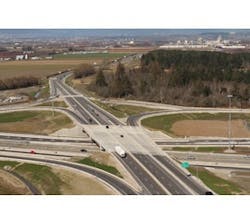NO. 4 ROAD: Quiet down
Few things discourage people from living in an area more than a noisy neighborhood.
That was the situation in Delta and Surrey, B.C., at the end of 2010. Situated roughly 30 km southeast of Vancouver, the province’s second- and third-largest cities were seeing a lot of truck traffic on local roads. The British Columbia Ministry of Transportation and Infrastructure (MTO) wanted to find a way to keep commerce flowing and alleviate local traffic.
MTO turned to joint venture FTG Constructors and design consultant Stantec to imagine a solution. The design team was charged with keeping costs and environmental impact to a minimum. The second part especially was no small feat, considering the project area traveled through marshy swamp, a residential district and a First Nations archaeologically sensitive area.
Soil conditions provided one of the biggest challenges on the entire project, according to Paul Bohl, project manager for Stantec. The highway’s immediate proximity to the Fraser River made for swampy conditions to begin with, and the western portion of the new road ran through Burns Bog, the largest domed peat bog on the west coast of North America. As a result, said Bohl, “we were basically building three-quarters of this road on peat moss.”
The main concern in these swampy conditions was settlement, both short- and long-term. FTG Constructors opted for surcharging or pre-loading the soil in the worst areas. Extra soil was piled 2 meters higher than the intended grade of the finished roadway so that once the dirt settled, the grade would be correct.
The downside of this method, while effective, was that the surcharge loads required four to six months to settle enough for construction to resume. Wanting to stay on schedule as much as possible, the contractor used this time to bounce between the eight project segments and continue working wherever possible.
Surcharging was not the answer in every case, as there wasn’t always time to allow a surcharge load to settle fully. One of the more creative alternatives used was extruded polystyrene (EPS) foam fill, which provided a much lighter-weight option.
Pavement design proved tricky in the marshy conditions as well, with the team opting for an open-graded friction course (OGFC) on top. The reasons for choosing OGFC were two-fold: It made for a quieter pavement, and the team knew some touch-ups would be needed in the future.
As critical as it was to work around the bog, it was maybe even more important to respectfully handle the First Nations archaeological area. Several options were considered for passing the highway through, but it was ultimately decided to build a viaduct with a separate bridge over the site. This way, Bohl said, “the abutments and piers either missed the area or minimized the impact.”
Even in these conditions, FTG was able to maintain traffic throughout the corridor and gradually shift the flow onto the new roadway. The first segments opened in December 2012, and the full 25-mile South Fraser Perimeter Road began operation in December 2013—six months ahead of schedule. R&B
Project: South Fraser Perimeter Road
Location: Delta and Surrey, B.C.
Owner: British Columbia Ministry of Transportation & Infrastructure
Designer: Stantec
Contractor: FTG Constructors
Cost: $750 million
Start Date: June 2010
Completion Date: December 2013
